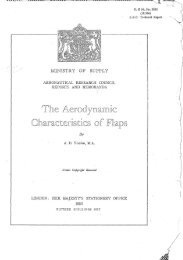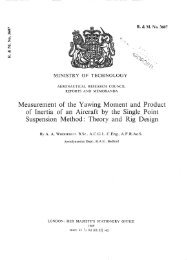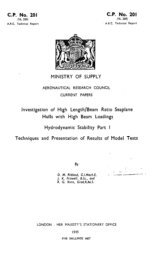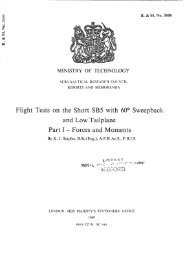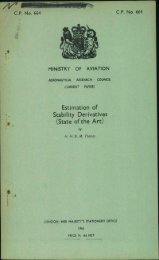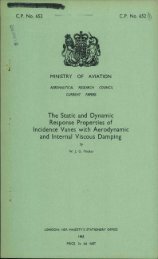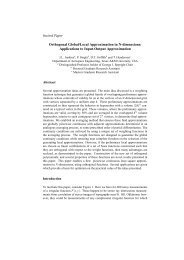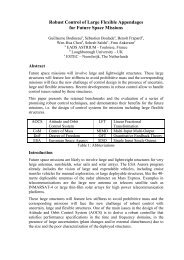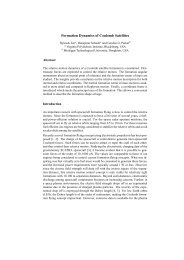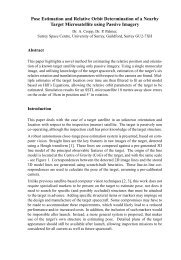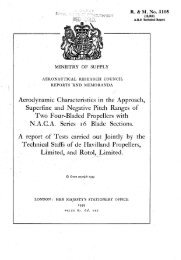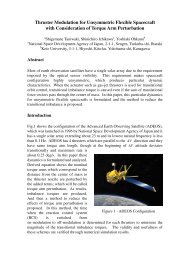A Survey of Unsteady Hypersonic Flow Problems
A Survey of Unsteady Hypersonic Flow Problems
A Survey of Unsteady Hypersonic Flow Problems
Create successful ePaper yourself
Turn your PDF publications into a flip-book with our unique Google optimized e-Paper software.
-7-<br />
flight and the altitude at which it takes place. For example, although a<br />
full analysis that till give the correct behavicur at extreme altitudes requires<br />
the ~IIC~US~OII <strong>of</strong> terms to acccxlnt for changes in the air density, gravity<br />
force, and other factors with altitude, and takes account Of the effective rate<br />
Of pitch due to the curvature <strong>of</strong> the flight path, the behaviour <strong>of</strong> the vehicle<br />
is dominated by the large values <strong>of</strong> the ratio <strong>of</strong> vehicle density t0 air density<br />
at which flight is possible. The longitudinal motion <strong>of</strong> the vehicle still<br />
exhibits two oscillatory normal modes, as at lower speeds. One mode involves,<br />
predominantly, changes <strong>of</strong> speed and altitude, and the other involves,<br />
predominantly, pitching oscillations. The second mode has a comparatively<br />
short period at the lower altitudes <strong>of</strong> hypersoac flight, and, under these<br />
conditions, it might involve unsteady fldw effects. Because <strong>of</strong> the large values<br />
Of relative density characteristic <strong>of</strong> hypersonic flight, the frequency parameters<br />
<strong>of</strong> normal modes are small and the rates <strong>of</strong> decay <strong>of</strong> the Oscillations are low.<br />
Qualitatively, the changes in the lateral behaviour Of vehicles at hypersonic<br />
speeds are similar to the changes Ln the longitudinal behaviour. The frequency<br />
parameters involved are likely to be rather higher than for the longitudinal<br />
motion, but they will still be codsiderably smaller than those at lower speeds.<br />
Analyses <strong>of</strong> the longitudinal oscillatory behaviour <strong>of</strong> vehicles in<br />
re-entry fllgbt show no essential ~iifferences from the behaviour in the case<br />
<strong>of</strong> level flight. At a given point in the trajectory, the frequency <strong>of</strong> the<br />
oscillatory pitching motion is the same as it would be for level flight at the<br />
Same speed and altitude, and the criteria for conver'gence <strong>of</strong> the motion can be<br />
shown to be the same in the two oases apart from the inclusion in the re-entry<br />
case <strong>of</strong> terms that are dependent on the drag <strong>of</strong> the vehicle, and the rate <strong>of</strong><br />
increase <strong>of</strong> air density.<br />
It is possible to set an approximate upper limit <strong>of</strong> 0'01 on the<br />
values <strong>of</strong> frequency parameter likely to be found in bypersonlc stability analyses.<br />
For values <strong>of</strong> the parameter in this range it should be possible to treat the<br />
flow as quasi-steady, althwgh accurate estimates <strong>of</strong> the aerodynamic damping may<br />
need rather careful examination <strong>of</strong> the boundary layer behaviour. The results<br />
Of stabilitg investigations do not show any conditions 1x1 which a very accurate<br />
knowledge <strong>of</strong> unsteady aerodynamic forces would be <strong>of</strong> critical importance for<br />
normal stability analyses, especially as artificial control Of the stability<br />
would probably be used in normal conditions. Nevertheless, if vehicles are<br />
designed for emergency manual control, or if it is required to analyse the<br />
uncontrolled motion <strong>of</strong> a re-entry vehicle, accurate values <strong>of</strong> aerodynamic<br />
forces might be important.<br />
4. Flutter <strong>of</strong> hersonic Vehicles<br />
The kinds <strong>of</strong> flutter likely to cccur at hypersonic speeds are<br />
determined chiefly by the form <strong>of</strong> the vehicles. From general technical<br />
cOnsideratiOns, it seems that the most likely form Of flutter involving the<br />
whOle vehicle structure will be either that <strong>of</strong> a slender body in bending mdes,<br />
Op Of a slender win&O+ combination involving flexure, torsion, and camber<br />
m&es Of the wing, and bending modes <strong>of</strong> the body. Panel flutter Could, also,<br />
be a problem Over those areas <strong>of</strong> the body surfaces where dynamic pressures can<br />
be high but the simple, conventional flexure/torsion flutter <strong>of</strong> lifting surfaces<br />
is cdy likely tobe encountered on certain kinds <strong>of</strong> Control surface.<br />
There have been Some analytical and experimental inVesti.gatiOnS <strong>of</strong><br />
the flutter <strong>of</strong> 10~ aspect ratio wings with chordwlse flexibility, and Of rigid<br />
cones with pitching and plunging flexibilities, but the majority <strong>of</strong> investigations<br />
have/



